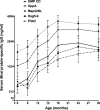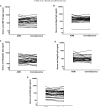Serum antibody response to Moraxella catarrhalis proteins OMP CD, OppA, Msp22, Hag, and PilA2 after nasopharyngeal colonization and acute otitis media in children
- PMID: 26392013
- PMCID: PMC4609635
- DOI: 10.1016/j.vaccine.2015.09.023
Serum antibody response to Moraxella catarrhalis proteins OMP CD, OppA, Msp22, Hag, and PilA2 after nasopharyngeal colonization and acute otitis media in children
Abstract
Background: There is no licensed vaccine for Moraxella catarrhalis (Mcat), which is a prominent bacterium causing acute otitis media (AOM) in children and lower respiratory tract infections in adults. Nasopharyngeal (NP) colonization caused by respiratory bacteria results in natural immunization of the host. To identify Mcat antigens as vaccine candidates, we evaluated the development of naturally induced antibodies to 5 Mcat surface proteins in children 6-30 months of age during Mcat NP colonization and AOM.
Methods: Human serum IgG against the recombinant Mcat proteins, outer membrane protein (OMP) CD, oligopeptide permease (Opp)A, hemagglutinin (Hag), Moraxella surface protein (Msp)22, and PilA clade 2 (PilA2) was quantitated by using an ELISA assay.
Results: There were 223 Mcat NP colonization episodes documented in 111 (60%) of 184 children in the study. Thirty five Mcat AOM episodes occurred in 30 (16%) of 184 children. All 5 Mcat candidate vaccine antigens evaluated stimulated a significant rise in serum IgG levles over time from 6 to 36 months of age (P<0.001), with a rank order as follows: Msp22=OppA>OMP CD=Hag=PilA2. Children with no detectable Mcat NP colonization showed a higher serum IgG level against OppA, Hag, and Msp22 compared to those with Mcat NP colonization (P<0.05). Individual data showed that some children responded to AOM with an antibody increase to one or more of the studied Mcat proteins but some children failed to respond.
Conclusions: Serum antibody to Mcat candidate vaccine proteins OMP CD, OppA, Msp22, Hag, and PilA2 increased with age in naturally immunized children age 6-30 months following Mcat NP colonization and AOM. High antibody levels against OppA, Msp22, and Hag correlated with reduced carriage. The results support further investigation of these vaccine candidates in protecting against Mcat colonization and infection.
Keywords: Acute otitis media; Antigen; Carriage; Immunogenicity; Nasopharyngeal colonization; Natural immunization; Recombinant proteins; Vaccine.
Copyright © 2015 Elsevier Ltd. All rights reserved.
Figures



Similar articles
-
Stringently Defined Otitis Prone Children Demonstrate Deficient Naturally Induced Mucosal Antibody Response to Moraxella catarrhalis Proteins.Front Immunol. 2017 Aug 11;8:953. doi: 10.3389/fimmu.2017.00953. eCollection 2017. Front Immunol. 2017. PMID: 28848555 Free PMC article.
-
Serum antibody response to Moraxella catarrhalis proteins in stringently defined otitis prone children.Vaccine. 2019 Jul 26;37(32):4637-4645. doi: 10.1016/j.vaccine.2017.07.027. Epub 2017 Jul 26. Vaccine. 2019. PMID: 28755833 Free PMC article.
-
Synchrony in serum antibody response to conserved proteins of Moraxella catarrhalis in young children.Hum Vaccin Immunother. 2020 Dec 1;16(12):3194-3200. doi: 10.1080/21645515.2020.1752562. Epub 2020 May 13. Hum Vaccin Immunother. 2020. PMID: 32401688 Free PMC article.
-
Current progress with Moraxella catarrhalis antigens as vaccine candidates.Expert Rev Vaccines. 2009 Jan;8(1):77-90. doi: 10.1586/14760584.8.1.77. Expert Rev Vaccines. 2009. PMID: 19093775 Review.
-
Ten-Year Study of Acute Otitis Media in Rochester, NY.Pediatr Infect Dis J. 2016 Sep;35(9):1027-32. doi: 10.1097/INF.0000000000001216. Pediatr Infect Dis J. 2016. PMID: 27182898 Review.
Cited by
-
Virulence factors of Moraxella catarrhalis outer membrane vesicles are major targets for cross-reactive antibodies and have adapted during evolution.Sci Rep. 2018 Mar 21;8(1):4955. doi: 10.1038/s41598-018-23029-7. Sci Rep. 2018. PMID: 29563531 Free PMC article.
-
Panel 7 - Pathogenesis of otitis media - a review of the literature between 2015 and 2019.Int J Pediatr Otorhinolaryngol. 2020 Mar;130 Suppl 1:109838. doi: 10.1016/j.ijporl.2019.109838. Epub 2019 Dec 19. Int J Pediatr Otorhinolaryngol. 2020. PMID: 31879085 Free PMC article. Review.
-
Increased growth rate and amikacin resistance of Salmonella enteritidis after one-month spaceflight on China's Shenzhou-11 spacecraft.Microbiologyopen. 2019 Sep;8(9):e00833. doi: 10.1002/mbo3.833. Epub 2019 Mar 25. Microbiologyopen. 2019. PMID: 30912318 Free PMC article.
-
Potential impact of a Moraxella catarrhalis vaccine in COPD.Vaccine. 2019 Sep 3;37(37):5551-5558. doi: 10.1016/j.vaccine.2016.12.066. Epub 2017 Feb 6. Vaccine. 2019. PMID: 28185742 Free PMC article. Review.
-
Stringently Defined Otitis Prone Children Demonstrate Deficient Naturally Induced Mucosal Antibody Response to Moraxella catarrhalis Proteins.Front Immunol. 2017 Aug 11;8:953. doi: 10.3389/fimmu.2017.00953. eCollection 2017. Front Immunol. 2017. PMID: 28848555 Free PMC article.
References
-
- Murphy TF, Parameswaran GI. Moraxella catarrhalis, a human respiratory tract pathogen. Clin Infect Dis: Off Publ Infect Dis Soc Am. 2009;49:124–31. - PubMed
-
- Kaplan B, Wandstrat TL, Cunningham JR. Overall cost in the treatment of otitis media. Pediatr Infect Dis J. 1997;16:S9–11. - PubMed
-
- Casey JR, Kauer R, Pichichero ME. Otopathogens causing acute otitis media in the 13-valent pneumococcal conjugate vaccine era. 18th international symposium on recent advances in otitis media. 2015
-
- Su YC, Singh B, Riesbeck K. Moraxella catarrhalis: from interactions with the host immune system to vaccine development. Fut Microbiol. 2012;7:1073–100. - PubMed
Publication types
MeSH terms
Substances
Grants and funding
LinkOut - more resources
Full Text Sources
Other Literature Sources
Medical
Research Materials
Miscellaneous

